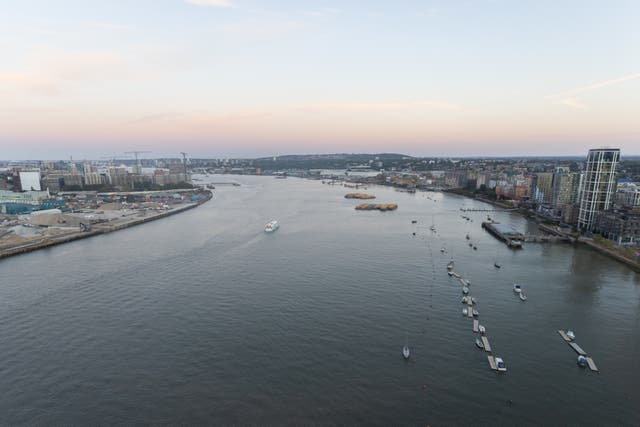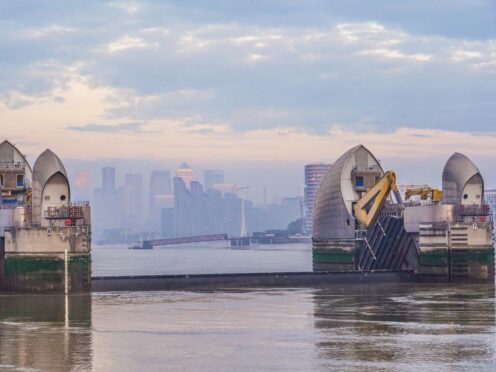Flood defence walls through London will need to be half a metre higher in the future to protect against climate change, officials said as they marked the 40th anniversary of the Thames Barrier.
The barrier, officially opened by Queen Elizabeth II, on May 8, 1984, and operated by the Environment Agency, was designed to protect London from flooding until 2030, but the “sleeping giant” is now expected to function until 2070.
The structure took eight years to construct, at a cost of £535 million – £2.4 billion in today’s money – and consists of 10 steel gates, with the main gates each as wide as the opening of Tower Bridge, weighing 3,300 tonnes, and as high as a five storey building when raised.
Since its construction, it has been closed 221 times to prevent flooding of the capital, working with other flood defences along the Thames to protect 1.42 million people, residential property worth £321 billion, hundreds of schools, hospitals, railway and train stations, and four World Heritage sites.

Without the barrier, officials said storm surges and frequent tidal flooding of the Thames would submerge buildings along the river – with only the City of London itself standing on high ground – risking lives and livelihoods and causing huge amounts of damage.
In the absence of the barrier, which is downstream from Greenwich and close to City Airport, the flood defence walls that line the Thames through central London would have to have been built up by another three metres, cutting off the city from its river.
But with sea levels expected to rise by a metre by 2100 along with increasingly intense storms driven by climate change, officials say greater defences against flooding will be needed in the coming decades.
These include raising the flood walls and defences that line the Thames downriver of the barrier by half a metre by 2040, and then by the same amount by 2050, to the west, through central London.
And a decision will need to be made by 2040 on what to do with the barrier itself, with options including upgrading the existing barrier by 2070, so that the gates are not overtopped by rising seas and storm surges, or installing a series of flood storage “reservoirs” downstream.
The other options are a new barrier with a similar design to the current one, which has moveable gates that lie flat on the riverbed when not needed to allow vessels to pass through and then swing up to close, or a permanent barrier with locks for river traffic.
The 40th anniversary also marks the final day in the job for Andy Batchelor, who has been the Thames Barrier’s manager for 25 years, having started a new job at the site on the day it was opened by the late Queen.
Mr Batchelor said: “Having witnessed and worked on the Thames Barrier’s opening, I am immensely proud of the protection it has provided London for the past 40 years and will continue to provide for years to come.
“Its reliability and effectiveness demonstrate the sophistication of its design by a very talented group of engineers and the continued maintenance and operation carried out by the Barrier team.”
He said of the barrier: “It’s like the sleeping giant, it rolls into action, it wakes up when that is needed.
“We have to maintain the giant in the background all the time,” he added, paying tribute to his team, who have a rolling programme of proactive maintenance, and routine closures, to keep the barrier working.
While the barrier has met the challenge it was designed for – including rising sea levels factored in before climate change was part of the conversation – the winter of 2013/2014 was extremely difficult.

Storms and weeks of heavy rain bringing high river flows down the Thames meant the barrier was closed 50 times in 13 weeks, including 20 closures on consecutive high tides.
If that intense use were to be replicated more frequently, it would not leave time for the maintenance the barrier needs to ensure it works when required.
So under the Thames Estuary 2100 plan by the Environment Agency and partners, the walls and defences that line the Thames will be raised by half a metre over the coming decades, which will allow the barrier to continue working for as long as possible.
Mr Batchelor added that despite the success in protecting London over the past 40 years, the Environment Agency “will not rest on our laurels given the threat of rising sea levels”, and would work with partners to review and decide on the right option for a new barrier by 2040.
